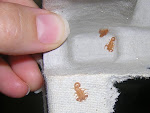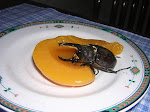
I'm trying to use other people's photos/art as little as possible on this blog. Mainly because I want to give proper credit, which, as I've found out, involves more than sticking their name beneath a picture I've lifted off the internet. And because I don't have a personal photo of something akin to the above -- and glad for that -- I'm stuck with microsoft clipart. (Have mercy, Bill Gates.)
Africanized honey bees (AHB) are not the "killers" our media so loves to hype them as. True, they can be dangerous and require a bit more caution.
AHBs, Apis mellifera scutella, are a subspecies of their more docile cousin, the European honey bee (EHB), Apis mellifera. The two look virtually alike. Only a trained entomological eye (not mine) can tell the two bees apart by measuring certain body parts (never let it be said entomologists aren't voyeurs). DNA tests also distinguish them. As AHBs have made their way north from Brazil, where they were introduced in the late '50s, they've hybridized with EHBs. ALL southwestern honey bees are now presumed to be a hybridized EHB/AHB sort. This simply means folks in the southwest need to approach all honey bees with greater caution and respect. For an example of the wrong approach to take, see the home owner's comments in my transcribed phone call below.
Underreported fact: AHB venom is not any more toxic than EHB venom. Rather, more people die in the attempt to escape AHBs than from actual toxic envenomation (which doesn't include deaths from allergic reaction, which can occur with a single sting). People run off cliffs, run into traffic, etc. Often times, people will flap and flail their arms, swatting the bees, such that if the colony wasn't interested in chasing them before, it may well have changed its collective mind.
AHBs maintain smaller colonies, so the break apart (also called fission or budding) more often. Budding involves "swarming" -- when the new queen takes a portion
 of the hive and sets out to find a suitable location to establish a colony. During this flight, she gives off an intoxicating cocktail of pheromones that the bees are drawn to. When the queen needs to rest -- be it on a tree branch or in an irrigation box -- the other bees surround her, fanning her with their wings to keep her cool if necessary. This can go on for 1-3 days. There is no hive to protect, no young to guard. So the bees in this situation are as disinterested in humans as they're ever likely to be. And yet, it is not unusual to see people committing desperate acts of fear, leading to injury or death, to escape what is, sadly, a swarm of bees...high on pheromone...just passing through.
of the hive and sets out to find a suitable location to establish a colony. During this flight, she gives off an intoxicating cocktail of pheromones that the bees are drawn to. When the queen needs to rest -- be it on a tree branch or in an irrigation box -- the other bees surround her, fanning her with their wings to keep her cool if necessary. This can go on for 1-3 days. There is no hive to protect, no young to guard. So the bees in this situation are as disinterested in humans as they're ever likely to be. And yet, it is not unusual to see people committing desperate acts of fear, leading to injury or death, to escape what is, sadly, a swarm of bees...high on pheromone...just passing through.In other instances, people encounter AHBs in their homes or yards after a hive has been established. In this scenario AHBs are likely to be more defensive than EHBs. When defending a hive, AHBs tend to react more quickly to intruders, and they have a broader definition of what an intruder is. It's like personal space, and AHBs need more of it. When one stings, it sets off a chain reaction via pheromone, as with other honey bees, except that more AHBs give chase compared to EHBs, and will chase farther. AHBs stay ticked off a little longer than EHBs, too. Running the length of two football fields to escape an agitated AHB hive is the general rule of thumb. So AHBs defending hives certainly can be dangerous, depending on the level of threat they perceive.
A 56-kilogram (125 lb) adult can sustain 728 honey bee stings and still survive (assuming good cardiopulmonary health).
(source: Justin O. Schmidt)
I noted this while at a presentation by Dr. Schmidt last year. It was again at the forefront of my mind while hiking down a steep slope recently. I was zoning and suddenly found myself standing amidst dozens of bees. They were zestfully circling in the sun as far out as 10 feet from the nest, which, as far as I could tell, was right where I stood. Quite a few were coming and going from the nest -- somewhere near my knees -- with clear intention. I figured I was a goner. Surely I had violated the boundaries of an AHB hive's space. I kept my head down, quickened my pace, tucked my arms into my sides so as not to flail, and bristled for the "attack". There wasn't one. I stopped 30 feet away and turned to face the scene. The nest was recessed in a 5-inch crack of a rock formation, just a few inches to the side of the trail. I watched the "killer" bees for a while, fascinated and thankful.
For more information on Africanized honey bees visit the Carl Hayden Bee Research Center.
+reduced.jpg)


1 comment:
You don't need to post this - not trying to advertise through your site - nicely written article, by the way.
1. Welcome to use our photos - http://www.aaabeeremoval.com.
2. Welcome to view our blog: africaizedhoneybees.blogspot.com
Correction, as an old beekeeper, the old queen leaves with the swarm.
Additionally, most people will go into shock before they reach a fatal level of envenomation.
Last, they are not always aggressive, but they can be. You may have felt lucky, probably were, but they had no reason to notice you or percieve you as a threat - there are also certain times in a colony's life cycle when they are much more aggitated.
Thanks for the article, nicely done.
Post a Comment